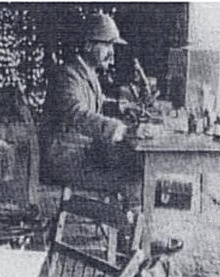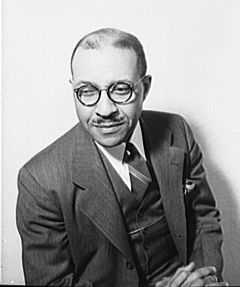Cuthbert Christy
| Cuthbert Christy | |
|---|---|
 Christy in Uganda in 1902 | |
| Born | 1863 |
| Died |
29 May 1932 (aged 68–69) Aka River region, Belgian Congo |
| Nationality | British |
| Occupation | Doctor, Explorer |
| Known for | Christy commission report on slavery in Liberia |
Cuthbert Christy (1863 – 29 May 1932) was a British doctor and zoologist who undertook extensive explorations of Central Africa during the first part of the 20th century. He was known for his work on sleeping sickness, and for the Christy Report on practices very similar to slavery in Liberia in the 1920s.
Early years
Cuthbert Christy was born in 1863, son of Robert Christy of Chelmsford. He was educated as Scarborough, then won a Mackenzie bursary to the University of Edinburgh.[1] He graduated in 1892.[2] He traveled widely in South America and the West Indies between 1892 and 1895. He was senior medical officer to the second battalion, West African Field Force in Northern Nigeria from 1898 to 1900. He was then appointed special medical officer for plague duty in Bombay, working in the Plague Laboratory in that city.[1]
African travels
Christy became a highly skilled naturalist. In 1902 he was chosen as a member of a three-man British government commission to investigate trypanosomiasis (sleeping sickness) in Uganda. The other two were George Carmichael Low and Aldo Castellani.[2] An epidemic of the disease was raging in Uganda, and almost 14,000 people had died by the spring of 1902. The three man reached Kisumu in July 1902.[3] Christie undertook a survey to create a map showing where the disease was found, traveling from place to place, taking blood samples, recording symptoms and trapping mosquitoes.[2]
Christy was a member of a team sponsored by the Liverpool School of Tropical Medicine that arrived in the Congo Free State on 23 September 1903 to assess public health, and sleeping sickness in particular. His companions were Joseph Everett Dutton and John Lancelot Todd, and they were joined in the Congo by Inge-Valdemar Heiberg. The team spent nine months in the Lower Congo, then on 30 June 1904 began investigating upstream as far as Kasongo.[4] They returned to Boma on 27 February 1905. The emphasis was on the health of Europeans. Despite covering a large area, the expedition did not investigate the huge tracts where few or no Europeans were present.[5] Christy worked in Ceylon in 1906, in Uganda and East Africa from 1906 to 1909, and then in Nigeria, the Gold Coast and the Cameroons from 1909 to 1910. In 1911 he published The African rubber industry and Funtumia elastica ("kickxia").[6]
Between 1911 and 1914 Christy worked for the Belgian government in the Belgian Congo, mostly studying sleeping sickness. For more than a year he explored the forests to the west of Mbeni and the Rwenzori Mountains.[1] During World War I (1914–1918), between 1915 and 1916 he worked for the Sudan government in mapping the Congo-Nile Divide, which divided the Congo from the Sudan.[7] In part to reduce the spread of disease, the colonial authorities had imposed increasing travel restrictions on the local people. Christy observed that far more passports for cross-border travel were being issued by the Congolese authorities than by the Sudanese. He said that the main pretext was to hunt for a runaway woman, but the main reason was to trade in rubber.[8] In 1916 Christy was appointed Advisor for Malaria to the East African Expeditionary Force. He was in charge of the military hospital in Dar es Salaam, and then in Mesopotamia.[7]
Between 1920 and 1923 Christy explored the Bahr el Ghazal in what is now South Sudan. From 1925 to 1928 he was leader of an expedition arranged by the Natural History Museum to explore the Tanganyika lakes.[7] Christy was employed in French Equatorial Africa and French West Africa from 1928 to 1929.[6]
Christy commission

In 1929 an American missionary in Liberia reported that Liberian officials were using soldiers to gather tribal people who were shipped to the island of Fernando Po as forced laborers.[9] The Liberian government denied the charges and invited a League of Nations commission of inquiry. Cuthbert Christy headed the commission.[10] Charles S. Johnson, a black American, was the United States representative.[11] The former President Arthur Barclay represented Liberia. The commission began work on 8 April 1930.[6] While Arthur Barclay remained in Monrovia for reasons of health, after six weeks Christy and Johnston left the capital and traveled first together, then separately, into the interior where they took testimony. They returned in July and conducted further interviews. Altogether the commission members heard 264 people including politicians, officials, chiefs and ordinary people.[12]
Christy was generally negative towards the role of the United States in Liberia, and interested in showing that the Firestone Tire and Rubber Company was complicit in slaving.[13] Christie and Johnson disagreed in their interpretation of the findings, with Johnson saying that "His [Christy's] ... hysterical, extreme statements in summary fashion [condemned] the whole government and [called] everything slavery, slave dealing, slave traffic, etc."[12] At root was a disagreement over whether the abuses could be remedied under black self-rule, with Christy eventually coming round to Johnson's view that the country should remain independent.[14]
Although much of the work was done by the other team members, it was important to Christy to take most of the credit.[15] The result of the inquiries was an outspoken report submitted in September 1930. It found that the laborers had been recruited "under condition of criminal compulsion scarcely distinguishable from slave raiding and slave trading."[10] As a result of the Christy report, President Charles D. B. King and Vice-president Allen N. Yancy both resigned.[16]
Death and legacy
Charles S. Johnson said soon after meeting him in 1930 that although he was 66 he "looks and has the heartiness of a man of 45."[13] Christy was also extremely vain.[2] He has been called "a most difficult and irascible man."[4] In 1932 Christy was in the Aka River region of the Belgian Congo. He was conducting zoological investigation for the Belgian government, and was in search of elephants. He fired at a male buffalo. The wounded animal charged and gored him, and he later died of his wounds on 29 May 1932.[1]
Naja christyi, commonly known as the Congo water cobra or Christy's water cobra, is named after him, as are Chamaelycus christyi (Christy's Banded Snake) and Polemon christyi (Christy's Snake-eater).[17]
Bibliography
- Christy, Cuthbert (1900). Mosquitoes and malaria: a summary of knowledge on the subject up to date; with an account of the natural history of some mosquitoes. Sampson Law, Marston & Co., Ltd. Retrieved 2013-05-07.
- Christy, Cuthbert; Castellani, Aldo; Low, G.C. (1903). The distribution of sleeping sickness. Harrison. Retrieved 2013-05-07.
- Christy, Cuthbert; Theobald, Frederick V. (1903). The epidemiology and etiology of sleeping sickness in Equatoriae East Africa. Harrison. Retrieved 2013-05-07.
- Dutton, Joseph Everett; Todd, John Lancelot; Christy, Cuthbert; Harold Wolferstan Thomas, Ernest Edward Austen (1904). Reports of the Trypanosomiasis Expedition to the Congo 1903–1904 of the Liverpool School of Tropical Medicine and Medical Parasitology. Williams & Norgate for the University Press of Liverpool. Retrieved 2013-05-07.
- Christy, Cuthbert (1911). The African rubber industry and Funtumia elastica ("kickxia"). J. Bale, Sons & Danielson, Limited. Retrieved 2013-05-07.
- Christy, Cuthbert (1917). Notes on Malaria for The Guidance of Officers and Men. Cape Times. Retrieved 2013-05-07.
- Christy, Cuthbert (1917). The Nile-Congo Watershed. William Clowes and Sons. Retrieved 2013-05-07.
- Christy, Cuthbert (1924). Big Game and Pygmies: Experiences of a Naturalist in Central African Forests in Quest of the Okapi. Macmillan and Company, Limited. Retrieved 2013-05-07.
- Stephenson, John; Christy, Cuthbert (1928). Cuthbert Christy Expedition, 1926. Retrieved 2013-05-07.
- Christy, Cuthbert (1931). Report of the International commission of inquiry into the existence of slavery and forced labor in the republic of Liberia. Monrovia, Liberia, September 8, 1930. U.S. Govt. print. off. Retrieved 2013-05-07.
- Christy, Cuthbert (1945). Notes on the Prevention of Malaria. Ross Institute of Tropical Hygiene, London School of Hygiene & Tropical Medicine. Retrieved 2013-05-07.
- Tredre, R. Ford; Christy, Cuthbert (1966). Notes on the Preservation of Personal Health in Warm Climates. Ross Institute of Tropical Hygiene. Retrieved 2013-05-07.
References
Notes
Citations
- ↑ 1.0 1.1 1.2 1.3 Dr. Cuthbert Christy: Royal Afr. Soc., p. 339.
- ↑ 2.0 2.1 2.2 2.3 Krishnamurthy 2002, p. 279.
- ↑ Lyons 2002, p. 70.
- ↑ 4.0 4.1 Lyons 2002, p. 76.
- ↑ Lyons 2002, p. 77.
- ↑ 6.0 6.1 6.2 Sundiata 2004, p. 132.
- ↑ 7.0 7.1 7.2 Dr. Cuthbert Christy: Royal Afr. Soc., p. 340.
- ↑ Lyons 2002, p. 205.
- ↑ Briggs 1998, p. 68.
- ↑ 10.0 10.1 Briggs 1998, p. 69.
- ↑ Sundiata 2004, p. 131.
- ↑ 12.0 12.1 Sundiata 2004, p. 133.
- ↑ 13.0 13.1 Gilpin & Gasman 2003, p. 82.
- ↑ Sundiata 2004, p. 134.
- ↑ Gilpin & Gasman 2003, p. 84.
- ↑ Van der Kraaij 2013.
- ↑ Beolens, Watkins & Grayson 2011, p. 54.
Sources
- Beolens, Bo; Watkins, Michael; Grayson, Michael (2011-07-26). The Eponym Dictionary of Reptiles. JHU Press. ISBN 978-1-4214-0135-5. Retrieved 2013-05-07.
- Briggs, Ellis (1998). Proud servant: the memoirs of a career ambassador. Kent State University Press. p. 69. ISBN 978-0-87338-588-6. Retrieved 2013-05-07.
- "Dr. Cuthbert Christy". Journal of the Royal African Society (Oxford University Press on behalf of The Royal African Society) 31 (124). July 1932. Retrieved 2013-05-07.
- Gilpin, Patrick J.; Gasman, Marybeth (2003). Charles S. Johnson: leadership beyond the veil in the age of Jim Crow. SUNY Press. ISBN 978-0-7914-8606-1. Retrieved 2013-05-07.
- Krishnamurthy, K. (2002). Pioneers in scientific discoveries. Mittal Publications. p. 279. ISBN 978-81-7099-844-0. Retrieved 2013-05-07.
- Lyons, Maryinez (2002-06-06). The Colonial Disease: A Social History of Sleeping Sickness in Northern Zaire, 1900-1940. Cambridge University Press. ISBN 978-0-521-52452-0. Retrieved 2013-05-07.
- Sundiata, Ibrahim (2004-01-13). Brothers and Strangers: Black Zion, Black Slavery, 1914–1940. Duke University Press. p. 132. ISBN 978-0-8223-8529-5. Retrieved 2013-05-07.
- Van der Kraaij, Fred P.M. (2013). "President Charles D.B. King". Liberia Past and Present. Retrieved 2013-05-07.